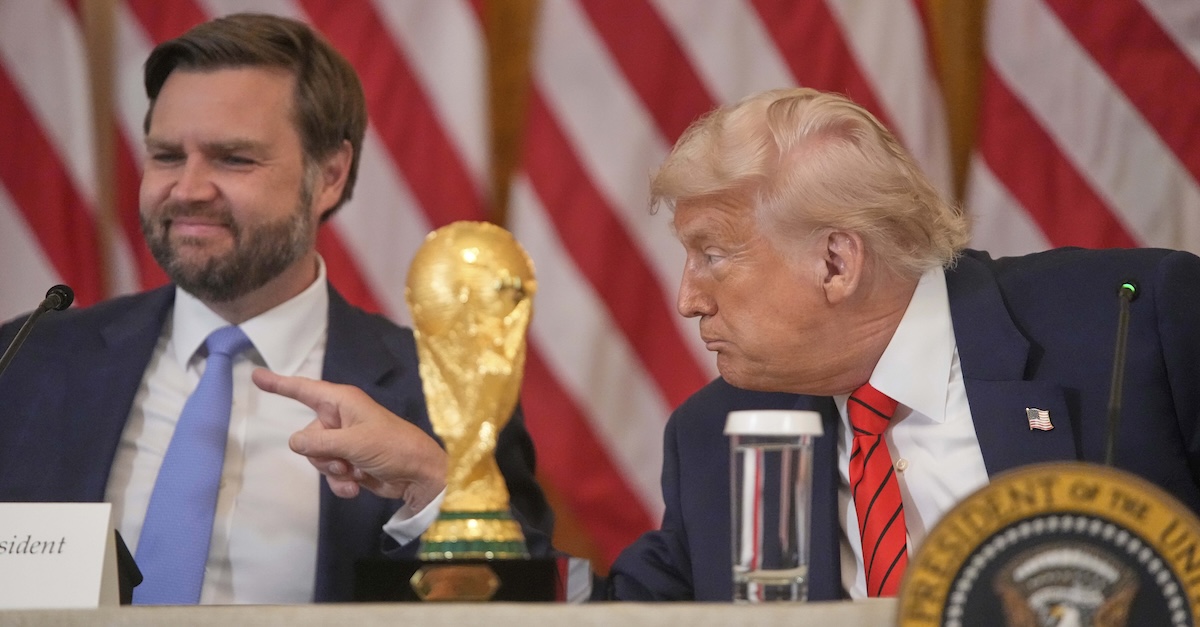
President Donald Trump gestures past Vice President JD Vance during a FIFA task force meeting on the 2026 FIFA World Cup in the East Room of the White House, Tuesday, May 6, 2025, in Washington (AP Photo/Mark Schiefelbein).
The Trump administration is imploring a federal court to allow the government to move forward with a suite of federally-enforced changes to some states” long-standing election laws.
On March 25, President Donald Trump issued Executive Order 14248, titled “Preserving and Protecting the Integrity of American Elections.” The order broadly seeks to reshape how elections are administered in the country by, among other things, purporting to enforce a requirement that all voters prove their citizenship by way of formal documentation and by putting a stop to vote-by-mail systems that count ballots postmarked by, but received after, Election Day.
Oregon and Washington – which have used vote by mail as their default voting mechanism for decades – originally sued for an injunction in early April and then moved to short-circuit the proceedings with a motion for partial summary judgment in late May.
Now, the Trump administration is looking to short-circuit the case in its own favor – and by using a different procedural posture.
Love true crime? Sign up for our newsletter, The Law&Crime Docket, to get the latest real-life crime stories delivered right to your inbox
On Monday, in a 41-page motion to dismiss, the government argues there is not even a “case” or “controversy” currently before the district. Rather, the U.S. Department of Justice argues, the states have asked the judge to adjudicate an “abstract dispute.”
“[T]his Court should dismiss this case without even reaching the merits,” the motion argues. “Plaintiffs’ claims also fail on the merits.”
For the majority of the claims leveled by the states, the Trump administration’s argument is a time-honored recitation of an analytical framework widely understood by legal scholars as “conservative standing doctrine.”
This judicial theory was created in two cases from the 1920s by conservative judges who sought to restrain the use and limits of constitutional redress. In other words, standing doctrine was created — and has over time been honed and sustained — to limit lawsuits against the government. While technically procedural in nature, as opposed to relying on the underlying merits arguments in a dispute, standing arguments tend to be fact-intensive.
Here, the government says the facts as alleged by the states simply do not add up to something that can even be challenged.
To hear the DOJ tell it, the section of Trump’s executive order that deals with proof of citizenship is, for now at least, a form of guidance instructing the Election Assistance Commission (EAC) to “take appropriate action” and begin the process of rulemaking. That process, the government says, has not concluded. And, since there is no actual rule to challenge, the states are suing too far in advance.
“Plaintiffs thus cannot establish the requisite ‘concrete and particularized’ and ‘actual or imminent’ injury in fact for standing purposes,” the motion to dismiss reads.
In fact, the government says, the only action taken toward the “documentary proof of citizenship” portion of the executive order is one letter sent by the EAC to state election officials “seeking ‘consultation’ on ‘development’ of the federal form” that will be used.
The paucity of action taken so far, the government says, also implicates the overlapping legal concept of ripeness – the idea that a lawsuit must challenge something at the appropriate time, lest it be deemed premature.
From the motion to dismiss, at length:
While standing seeks to keep federal courts out of disputes involving conjectural injuries, the ripeness doctrine seeks to prevent the adjudication of claims relating to “contingent future events that may not occur as anticipated, or indeed may not occur at all.”
…
Under these circumstances—where an operative rule has not even been proposed, much less promulgated in final form—Plaintiff States cannot establish that [the citizenship section of the executive order] is “fit” for review because future events have not yet occurred and, indeed, they “may not occur as anticipated.” This lack of finality and definiteness counsels against judicial intervention. Since a final rule does not yet exist, Plaintiff States do not yet know how they will be harmed—if at all.
More Law&Crime coverage: ‘Short-circuit Congress’ deliberative process’: Judge blocks parts of Trump order purporting to protect ‘integrity’ of US elections
The government largely reprises the same standing and ripeness arguments in order to defend the vote-by-mail section of Trump’s order – which is written in terms of enforcing current ballot receipt deadlines.
“What that action will be, how it will be enforced, and against whom is entirely speculative, and is not a basis for Article III standing or ripeness,” the motion to dismiss argues. “At the outset, the Attorney General has done nothing so far—and so any dispute about what she may do in the future, and whether any such action would violate Plaintiffs’ legal rights, is necessarily speculative.”
The executive order also contains additional language keyed toward enforcing the directive to require proof of citizenship. Chiefly, and challenged by the plaintiff states, are two sections which discuss combing through state voting records and “prioritizing” existing laws which limit noncitizen voting.
The government rubbishes Oregon’s and Washington’s concerns in exceedingly strong terms.
“Plaintiffs aver that [the two enforcement sections] will ‘harm Plaintiff States,’ but they do not explain how, when, or why,” the motion goes on. “Plaintiffs allege no facts to suggest that DHS or the Attorney General have taken any steps to review State records and do not explain what about either occurrence would harm them.”







